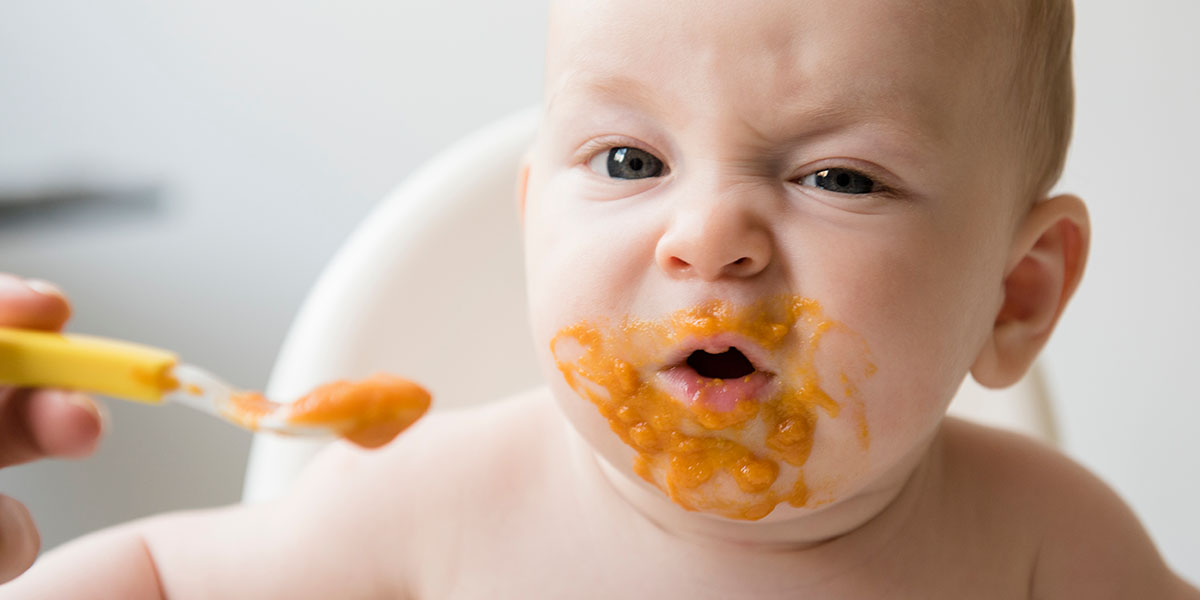
While starting solids is one of the most exciting milestones for a parent and their baby, it can also be nerve-wracking. Since your baby is brand new at eating and swallowing food, there is often a lot of spitting and gagging. How do you know if your little one is just gagging on a food they don’t like, or if they’re choking? We’re breaking it down.
What Is Gagging?
Gagging is a normal reflex in babies (and even adults), and is the body’s way of protecting us from choking. When gagging happens, the back of the throat contacts to protect the opening of the airway from becoming blocked. This natural function helps food make its way back up into the mouth and stop the swallowing reflex.
Gagging is extremely common and something every baby is likely to do as they learn to eat. After several months of practicing and as their gag reflex moves further back in the mouth, your little one will likely outgrow frequent gagging.
What Is Choking?
Choking occurs when the airway is partially or fully blocked, causing your child to have trouble breathing. The biggest indicator of choking versus gagging is that while gagging involves coughing or crying, true choking includes much more serious signs such as:
- Silence or the inability to cry
- Trouble breathing
- Look of panic
- Skin pulling to the chest
- Skin color changes (blue, purple, or extremely pale)
If any of these occur, it’s important to call 911 and begin administering first aid immediately (see below).
How to Respond If Your Baby Is Gagging or Choking
While gagging can certainly be a bit scary for parents, the gag reflex actually helps your little one learn how to eat correctly. For instance, it can help them know when a bite of food is too big, how to move the food around in their mouth and chew properly, and helps them adjust to foods that aren’t soft or pureed.
When your little one is gagging, take the following steps:
- Remain calm: If your baby sees you feeling panicked, they may get upset and panic, too.
- Don’t stick your finger in baby’s mouth: This could inadvertently push the food further into the throat, which could lead to choking.
- Stick your tongue out: Show your child how to push the food out of the back of their mouth by sticking your own tongue out and encouraging them to imitate you.
- Watch what happens next: Keep a close eye on baby to ensure they either spit out the food or continue to chew it and try to swallow again.
If your little one is choking, it’s important to act immediately and call 911 (have someone else nearby call when possible) and do first aid. For babies younger than 12 months old:
- Place baby face down on your forearm, resting your arm on your thigh.
- Give baby five quick, strong back blows using the heel of your hand between their shoulder blades to try and dislodge the food.
- If you’re unable to get the food out with the initial back blows, turn baby over and use two fingers to press down 5 times sharply on the middle of their chest, just below the nipples.
- Continue to repeat back blows and chest compressions until food is dislodged or medical assistance arrives to take over.
Taking an infant first aid class in-person or online is an excellent way to help you feel more comfortable and prepared while your baby learns how to eat properly.
What are Common Choking Hazards for Babies?
As your baby tries new foods, it’s important to know which solids present the highest risk of choking. Common foods known to cause choking include:
- Whole round-shaped foods such as grapes, berries, cherry tomatoes
- Cylindrical-shaped foods such as string cheese, whole bananas, hot dogs
- Whole nuts or beans
- Hard, round, or chewy candies
- Popcorn
- Large pieces of hard or uncooked fruit or vegetables
- Large pieces of meat and cheese
If you have questions or concerns about your baby’s readiness to try new foods, are concerned they are gagging too frequently, or suspect they are not eating correctly, schedule some time with their health-care provider. They may recommend a feeding specialist who can help your child learn how to eat correctly and safely.